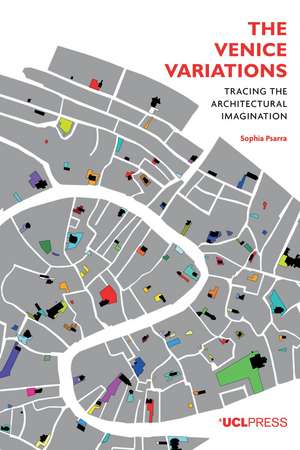Venice Variations: Tracing the Architectural Imagination
Autor Sophia Psarraen Limba Engleză Hardback – 14 aug 2018
From the myth of Arcadia through to the twenty-first century, ideas about sustainability—how we imagine better urban environments—remain persistently relevant and raise recurring questions. How do cities evolve as complex spaces nurturing both urban creativity and the fortuitous art of discovery, and by which mechanisms do they foster imagination and innovation? While past utopias were conceived in terms of an ideal geometry, contemporary exemplary models of urban design seek technological solutions of optimal organization. The Venice Variations explores Venice as a prototypical city that may hold unique answers to the ancient narrative of utopia. Venice was not the result of a preconceived ideal but the pragmatic outcome of social and economic networks of communication. Its urban creativity, though, came to represent the quintessential combination of place and institutions of its time.
Through a discussion of Venice and two other works owing their inspiration to this city—Italo Calvino’s Invisible Cities and Le Corbusier’s Venice Hospital—Sophia Psarra describes Venice as a system that starts to resemble a highly probabilistic "algorithm." The rapidly escalating processes of urban development around our big cities share many of the motivations for survival, shelter, and trade that brought Venice into existence. Rather than seeing these places as problems to be solved, we need to understand how urban complexity can evolve, as happened from its unprepossessing origins in the marshes of the Venetian lagoon to the "model city" enduring a thousand years. This book frees Venice from stereotypical representations, revealing its generative capacity to inform potential other "Venices" for the future.
Through a discussion of Venice and two other works owing their inspiration to this city—Italo Calvino’s Invisible Cities and Le Corbusier’s Venice Hospital—Sophia Psarra describes Venice as a system that starts to resemble a highly probabilistic "algorithm." The rapidly escalating processes of urban development around our big cities share many of the motivations for survival, shelter, and trade that brought Venice into existence. Rather than seeing these places as problems to be solved, we need to understand how urban complexity can evolve, as happened from its unprepossessing origins in the marshes of the Venetian lagoon to the "model city" enduring a thousand years. This book frees Venice from stereotypical representations, revealing its generative capacity to inform potential other "Venices" for the future.
Preț: 294.96 lei
Nou
Puncte Express: 442
Preț estimativ în valută:
56.44€ • 58.32$ • 46.95£
56.44€ • 58.32$ • 46.95£
Carte indisponibilă temporar
Doresc să fiu notificat când acest titlu va fi disponibil:
Se trimite...
Preluare comenzi: 021 569.72.76
Specificații
ISBN-13: 9781787352414
ISBN-10: 1787352412
Pagini: 288
Ilustrații: 149 illustrations
Dimensiuni: 152 x 235 x 30 mm
Greutate: 0.81 kg
Editura: UCL Press
Colecția UCL Press
ISBN-10: 1787352412
Pagini: 288
Ilustrații: 149 illustrations
Dimensiuni: 152 x 235 x 30 mm
Greutate: 0.81 kg
Editura: UCL Press
Colecția UCL Press
Notă biografică
Sophia Psarra is a reader at the Bartlett School of Architecture, UCL, and a practicing architect who has been part of prize-winning teams in international architectural competitions.
Cuprins
"Introduction: Between authored architecture and
the non-authored city
1. City-craft: Assembling the city
2. Statecraft: A remarkably well-ordered society
3. Story-craft: The imagination as combinatorial machine in
Italo Calvino’s Invisible Cities
4. Crafting architectural space: Le Corbusier’s Venice
Hospital and the three paradigms
Part 1: The Venice Hospital
Part 2: Geometry and space from Palladio to Le Corbusier
5. The Venice Variations: Tracing the Architectural
Imagination "
the non-authored city
1. City-craft: Assembling the city
2. Statecraft: A remarkably well-ordered society
3. Story-craft: The imagination as combinatorial machine in
Italo Calvino’s Invisible Cities
4. Crafting architectural space: Le Corbusier’s Venice
Hospital and the three paradigms
Part 1: The Venice Hospital
Part 2: Geometry and space from Palladio to Le Corbusier
5. The Venice Variations: Tracing the Architectural
Imagination "
